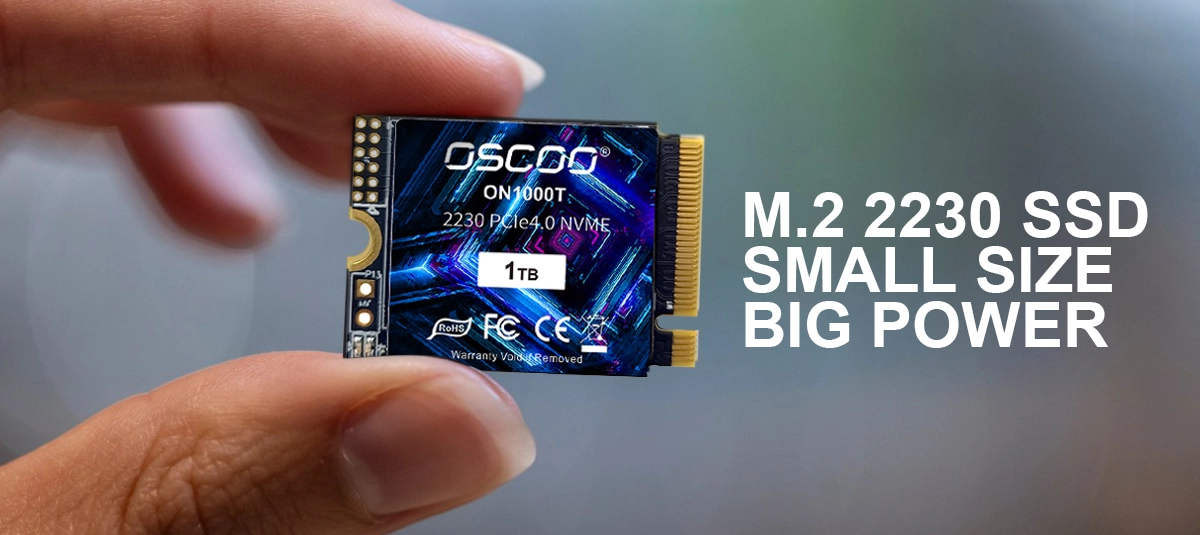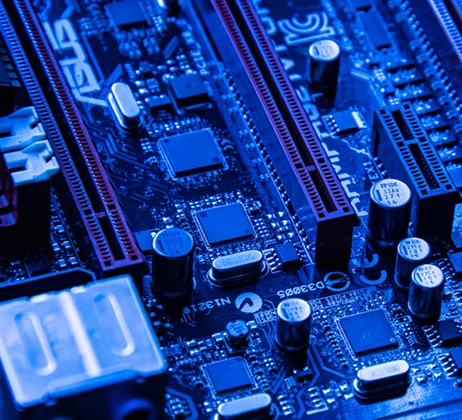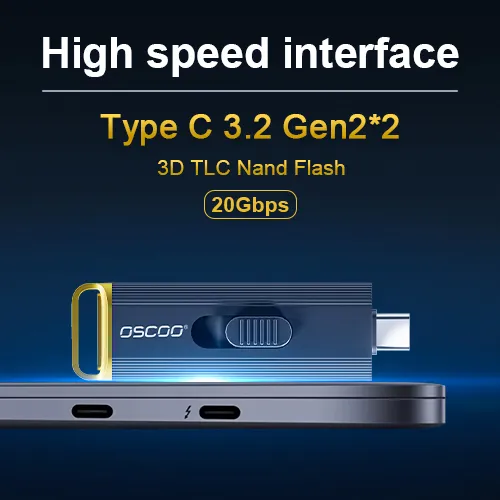
When looking to upgrade storage for a Steam Deck, compact laptop, or mini desktop PC, you might have first encountered the name M.2 2230 SSD. This term might sound technical, but it essentially refers to an extremely small solid-state drive. Its width is 22mm and its length is just 30mm. This ultra-compact design allows it to easily fit inside various portable devices with very limited internal space. As these devices become more popular, questions about this small drive’s performance, compatibility, and purchasing options are increasing. This article answers common questions like its speed, whether it fits larger machines, and where to buy it.
Índice
ToggleWhat Exactly is M.2 2230?
The name “M.2 2230 SSD” reveals three key details. “M.2” refers to a connector interface standard. This flat-slot interface is widely used on modern SSDs. The numbers “2230” directly describe the drive’s physical size: its width is fixed at 22mm, and its length is shorter, at 30mm. Simply put, an M.2 2230 SSD is a solid-state drive using the M.2 interface, measuring 22mm wide and 30mm long.
Its defining characteristic is extreme compactness. Compared to the common 2280 size SSD, the 2230 is less than half the length. This design specifically targets devices where internal space is extremely limited. Familiar examples like the Steam Deck gaming handheld and Microsoft’s Surface line of thin laptops rely on these ultra-small drives. Only the 2230 fits properly within their tightly constrained motherboard areas.
Regarding operation, 2230 SSDs follow the same rules as other M.2 drives. They support two different data transfer protocols. The most common and faster one is NVMe, which uses PCIe lanes for high-speed communication. Some models use the older, slower SATA protocol. Therefore, checking which protocol a specific 2230 SSD uses is crucial when purchasing or confirming specifications. Most available 2230 SSDs use the faster NVMe protocol, but always verify the specs before buying.
What's The Difference Between M.2 2280 and M.2 2230?
The most obvious difference is size. The common M.2 2280 SSD, as its name indicates, has a width of 22mm and a length of 80mm. The M.2 2230 keeps the same 22mm width but shortens the length to only 30mm. This means the 2280 is over two and a half times longer. Visually, the 2230 looks much smaller.
This leads to the first key question: Can they fit into each other’s slots? The answer is nuanced.
Can a 2230 fit into a 2280 slot? Usually yes. The M.2 interface has physical backwards compatibility. The small 2230 drive can physically plug into a longer 2280 slot. However, the critical issue is securing it. 2280 slots typically have their mounting screw hole positioned at the 80mm mark. A 30mm long 2230 drive inserted into this slot won’t align with the screw hole. You need a motherboard that provides extra screw holes at different distances or a special M.2 spacer/adapter. This small accessory plugs into the 2280 slot and provides a secure mounting point suitable for the 30mm length.
Can a 2280 fit into a 2230 slot? Absolutely not. The 2280 drive is simply too long. A 2230 slot physically lacks the space required for an 80mm drive. Just like a larger shoe won’t fit into a smaller box, the physical dimensions are a hard limit.
Does the smaller size mean lower performance? The answer might surprise you. When both drives use the same generation of PCIe lanes, the same controller chip, and the same quality flash memory chips, an M.2 2230 SSD can theoretically perform just as fast as an equivalent 2280 model. Drive speed limitations usually come from the controller, memory chips, and interface bandwidth, not the length of the circuit board. For everyday tasks and game loading, this small drive can deliver smooth, high-performance experiences.
However, the size difference does bring practical consequences. The selection of available 2230 SSD models is much smaller than for 2280 drives. Also, due to manufacturing scale and complexity, packing the same performance components into a smaller space typically makes 2230 SSDs slightly more expensive than 2280 drives at the same capacity. This is the extra cost for achieving such a compact size.
How Fast is The NVMe M.2 2230 SSD?
Don’t be fooled by its small size! The speed potential of an M.2 2230 SSD depends primarily on the version of the PCIe data transfer protocol it uses, followed by the quality of its internal controller and flash memory chips. The size itself is not a limiting factor for speed.
The mainstream protocol versions are PCIe 3.0 and PCIe 4.0. A 2230 SSD using PCIe 3.0 x4 lanes already offers strong performance. Common models achieve sequential read speeds around 2,000 to 3,500 MB/s and sequential write speeds between 1,500 and 3,000 MB/s. This speed is fully sufficient and very smooth for booting the system, running applications, loading large games, and handling everyday video or photo tasks.
OSCOO' s High-quality M.2 2230 SSDs

OSCOO ON900T M.2 2230 PCIe3.0 SSD
NVMe PCI3.0 x4; Capacity up to 2TB; Read/Write speed up to 3500/3000 MB/s; TBW up to 65oTBW

OSCOO ON1000T M.2 2230 PCIe4.0 SSD
NVMe PCI4.0 x4; Capacity up to 2TB; Read/Write speed up to 5200/4800 MB/s; TBW up to 1300TBW
If you want top-tier speed, 2230 SSDs supporting the newer, double-bandwidth PCIe 4.0 protocol show their true strength. Premium consumer PCIe 4.0 x4 models, like the OSCOO ON1000T, can easily break 5,000 MB/s sequential read speeds! Sequential write speeds also reach impressive highs. This means you’ll feel significantly faster responses when copying huge files or loading the latest AAA games.
Remember one thing: manufacturers’ advertised top speeds usually refer to sequential performance, which shines during large file transfers. What matters more for everyday responsiveness is random read/write performance, or IOPS. This affects how fast the system runs, programs launch, and games load numerous small files. Fortunately, excellent 2230 SSDs also provide very high random performance.
Therefore, when evaluating a 2230 SSD’s speed, focus on its PCIe protocol version and the specific model’s performance numbers. This “pocket rocket” can deliver speeds matching or even exceeding larger drives.
Can I Put a 4.0 NVMe in a 3.0 Slot?
This is a common concern for users upgrading storage. The answer is: Absolutely yes!
You can install a faster NVMe M.2 2230 SSD supporting the PCIe 4.0 standard into an older motherboard slot that only supports the PCIe 3.0 specification.
The principle behind this is called backward compatibility. Modern SSD interfaces are designed with older devices in mind. When you plug a PCIe 4.0 SSD into a PCIe 3.0 slot, the computer motherboard and the SSD automatically negotiate. The SSD will ultimately run in PCIe 3.0 x4 mode.
At this point, the SSD’s performance is limited by the PCIe 3.0 x4 interface bandwidth. This cap has a theoretical maximum of around 3,940 MB/s. So, even if you bought a high-end PCIe 4.0 SSD rated for 5,000 MB/s or 7,000 MB/s, its actual speed in this older PCIe 3.0 slot will max out near 3,940 MB/s.
Does this speed reduction make a noticeable difference in real-world use? The good news is that for the vast majority of daily operations and gaming, this speed is completely adequate. The difference in experience is hardly noticeable.
Whether booting the operating system, launching office software or a browser, or loading large games from your Steam library, speeds near 4,000 MB/s provide very snappy responses. Even copying large files remains efficient.
There’s also a potential future benefit: upgrade flexibility. If you later upgrade your motherboard or device to a platform supporting PCIe 4.0, this already installed SSD can automatically switch to high-speed mode without needing replacement. You immediately gain its full potential speed. This is especially convenient for Steam Deck owners planning upgrades. Of course, it’s always prudent to confirm your old device’s exact slot specifications before installing anything.
Is There a 4TB 2230 SSD?
The idea of a 4TB upgrade for a compact Steam Deck or ultra-thin laptop is tempting. However, the reality is that finding a consumer-grade, readily available 4TB M.2 2230 SSD is nearly impossible. As of writing, the maximum capacity offered by mainstream brands for consumer 2230 SSDs is typically 2TB (such as OSCOO’s ON900T y ON1000T ssd.
Why? The core limitation is the tiny 22mm x 30mm physical space. Drive capacity depends directly on how many NAND flash memory chips can fit onto the circuit board. Achieving a massive 4TB capacity in such a small area requires the most cutting-edge, ultra-high-density flash chips and possibly specialized multi-layer stacking designs. This is not only technically challenging but also significantly increases manufacturing cost and complexity.
While some extremely niche channels or enterprise markets might have 4TB 2230 drives, they are usually exorbitantly priced, difficult to obtain, and not standard consumer retail products. For most users, 2TB is the highest readily available capacity for 2230 drives, with 1TB being the most practical value choice.
Is there hope for the future? Yes, the outlook is optimistic. As NAND flash technology advances, particularly with higher-density QLC and future PLC chips maturing, fitting more data into smaller spaces becomes feasible. Manufacturers are also constantly refining stacking and packaging techniques. Therefore, it’s reasonable to expect consumer-grade 4TB and higher-capacity 2230 SSDs to enter the market within the next few years. But right now, for users needing massive storage, a larger 2280 SSD might be a more realistic option if your device supports it.
Are 2230 SSDs Reliable?
Seeing the tiny M.2 2230 SSD, many naturally wonder: Is it more fragile or shorter-lived than a larger SSD? The answer is: Reliability and long-term durability depend fundamentally on component quality, manufacturing processes, and brand quality control standards. The physical size itself is not a key factor determining reliability. A 2230 SSD from a reputable brand like OSCOO, using proven designs and quality components, can offer the same level of long-term stable operation as a similarly built 2280 model.
A key metric manufacturers use to quantify SSD lifespan is TBW. This represents the total amount of data that can be written to the drive over its warranty period. A higher number means a longer theoretical lifespan. Many 1TB capacity 2230 NVMe SSDs have TBW ratings typically between 300TB and 600TB (OSCOO’s ON1000T ssd can achieve up to 1300TB). For the vast majority of typical users, even writing tens of gigabytes daily, reaching this limit would take many years. Wearing out the drive through normal use is generally not a concern.
However, the small size does present a unique challenge: thermal rendimiento. The tiny circuit board offers very limited surface area for passive cooling. During intense, sustained read/write tasks, like continuously writing large game files or rendering big videos, the internal controller chip and flash memory chips can generate significant heat, causing temperatures to rise quickly.
Overheating can cause two potential problems. First, excessive heat can force the controller to temporarily reduce performance to protect itself. This is known as thermal throttling, extending task completion times. Second, long-term operation under very high temperatures might theoretically have subtle impacts on the long-term stability of electronic components.
How to manage thermal challenges? Here are some practical tips:
- Focus on Thermal Design: Prioritize models known for good temperature control in reviews. Some controller chips are inherently designed to run cooler.
- Utilize Device Cooling: Devices like the Steam Deck have built-in thermal pads designed to help cool the SSD. Ensure good contact when installing a new drive.
- Add a Heatsink if Possible: If you’re installing it in a DIY desktop PC or a compatible mini PC with enough space, consider adding a thin copper or graphene heatsink to increase the cooling surface area effectively.
- Avoid Extreme Loads: Try to avoid writing massive amounts of data non-stop at peak speeds for hours on end.
In summary, regarding component reliability and lifespan metrics, a quality 2230 SSD is dependable. Users just need to be mindful of its specific thermal characteristics, make sensible choices, and manage it appropriately to ensure it runs both fast and reliably for the long term.
What is Compatible with 2230 SSD?
The M.2 2230 SSD’s unique size means it’s not universally compatible. Determining if it works in your device depends on two key factors: physical space compatibility and data protocol support.
The first point is physical size compatibility. Your device must have an M.2 slot specifically designed for the 2230 length. Alternatively, the slot needs to support multiple lengths and provide a compatible screw hole or mounting mechanism at the correct position 30mm from the connector. If there’s no dedicated 30mm screw hole, as mentioned earlier, you’ll need an extra mounting bracket or adapter to secure the 2230 SSD properly. Crucially, if your device’s M.2 slot is designed for a shorter size like 2242 or 2230, a longer 2280 drive simply will not fit.
The second point is protocol support. Your device’s M.2 slot and motherboard must support the data transfer protocol used by the 2230 SSD you purchase. Currently, the vast majority of 2230 SSDs use the high-performance NVMe over PCIe protocol. Therefore, your device’s M.2 slot needs to support the NVMe protocol. If you happen to buy a very rare SATA-based 2230 SSD, your device’s slot must support SATA. Always confirm exactly which protocols your device’s M.2 slot supports before buying a drive.
Which devices commonly use 2230 SSDs? Here are typical examples:
- Gaming Handhelds: Valve Steam Deck (comes with 2230), ASUS ROG Ally (some versions), Lenovo Legion Go (some versions).
- Thin and Light Laptops: Many Microsoft Surface Pro and Surface Laptop Studio models, some Dell XPS 13 configurations, select Lenovo Yoga Slim/ThinkPad X series ultraportables, Acer Swift X models with space constraints.
- Mini PCs / Small Factor de forma Desktops: Some Intel NUC models (especially newer or ultra-compact ones), certain Gigabyte BRIX Mini-PC versions, and other compact mini PCs.
- Specialized Devices: Some routers with storage expansion slots, small industrial computers, compact embedded systems.
A critical final recommendation: Before purchasing any 2230 SSD to upgrade your device, always consult the device’s official specifications or user manual. Confirm that the M.2 slot explicitly supports the 2230 length and the NVMe protocol (or SATA protocol if applicable). Do not rely on guesswork or past experience, as this could lead to installation failure or the drive not being recognized. Verifying compatibility beforehand is the safest approach.
What to Consider When Buying an M.2 2230 SSD
When choosing an M.2 2230 SSD for your compact device, besides speed and capacity discussed earlier, consider these key points:
- Define Your Needs & Device Limits: First, determine the capacity you need. 512GB is entry-level, 1TB is the current sweet spot, and 2TB satisfies large storage demands. Also, confirm the maximum capacity your device supports. Second, know the highest PCIe protocol version your device supports. Buying an expensive PCIe 4.0 SSD is inefficient if your device only supports PCIe 3.0.
- Key Performance Metrics: Check the product’s sequential read/write speeds and random read/write performance. Random performance, measured in IOPS, often impacts daily responsiveness more directly. The TBW rating indicates theoretical endurance; higher is better. Understanding if the SSD has DRAM cache is also useful, as models with cache generally offer more stable performance.
- Thermal Management is Crucial: Due to tight spaces, actively consider the drive’s heat dissipation. Look for professional reviews detailing temperature behavior under load and the likelihood of thermal throttling. Prioritize models known for good thermal control or specifically optimized for cooling.
- Brand Reputation & Warranty: Choose products from well-known brands offering reliable warranties (OSCOO offers 3-year warranty for our products). Read warranty terms carefully, noting the duration and write limits. Good after-sales support provides peace of mind.
- User Feedback & Professional Reviews: Before buying, explore user forums for real-world experiences, especially regarding compatibility, stability, and temperature issues. Also, consult multiple professional reviews to get a well-rounded view of performance and reliability.
Summary
The M.2 2230 SSD, with its small size and high performance, has become the ideal storage solution for portable devices. While currently facing constraints like thermal management and capacity ceilings, ongoing technological advancements and market growth will lead to better performance, higher capacities, and improved cost efficiency. This will continue to enhance the experience of using thin and light devices.




